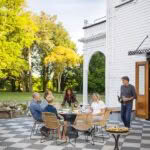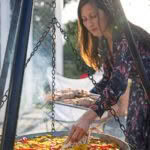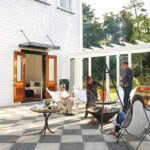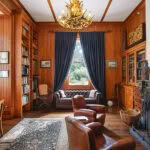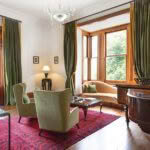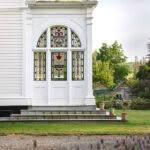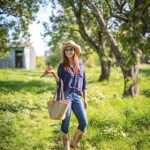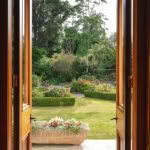Victorian-era homestead in Hawke’s Bay gets lovingly renovated by film producer Tim Coddington
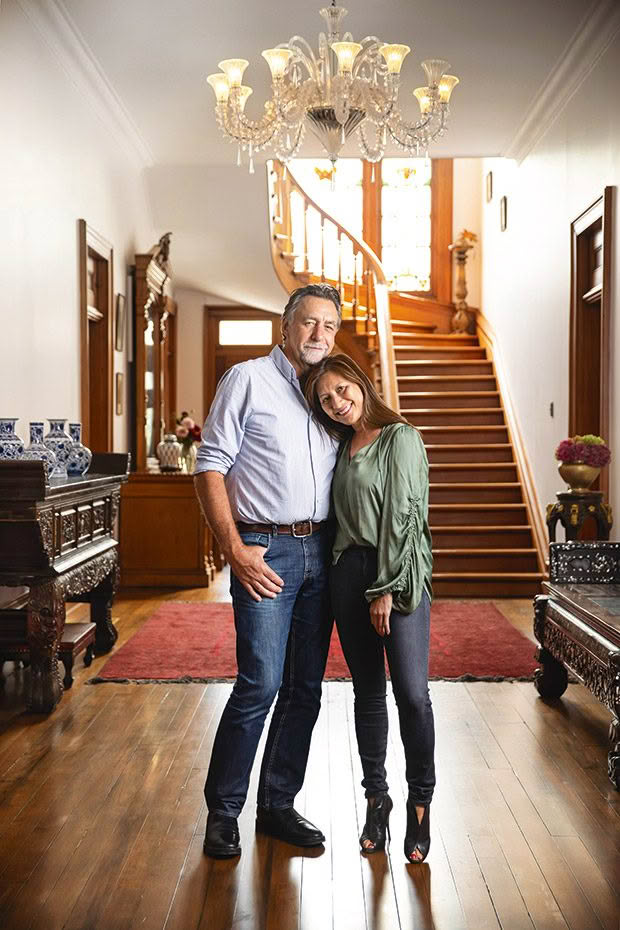
Tim Coddington and Duyen Hackett’s renovated Category 1-listed historic villa in Waipukurau is a welcome sight after the couple has been away for months at a time for work.
Of all the far-flung places this couple has been — and film sets they’ve seen — a heritage villa in rural Hawke’s Bay is the showstopper that surpasses them all.
Words: Cari Johnson Photos: Tessa Chrisp
For some, there is a precise moment when destiny comes stampeding in, centre stage. For Tim Coddington, it was the day he walked onto his first film set for the 1984 Kiwi western Wild Horses. Although hired as a horse wrangler, Tim couldn’t shake the feeling his non-equine colleagues needed a little rounding up and he was the one to do it. This movie thing was it. He could feel it.
Not that Tim, now an executive film producer, had much formal production experience to prove it back then. As far as his CV was concerned, the former military officer was proficient in showjumping, sheep shearing and pretty much anything that could be sorted with graft and creativity, a can-do attitude honed while growing up on his parents’ small sheep farm near Waipukurau, an hour’s drive southwest of Napier.
Looking back, Tim always had the makings of a producer. “Film production is like farming — decisions have to be made quickly based on the information you have at hand. And when dealing with livestock, there’s no time to procrastinate or do a workshop on how to get the best outcome. Decisions must be made quickly and regardless of potential consequences,” says Tim.
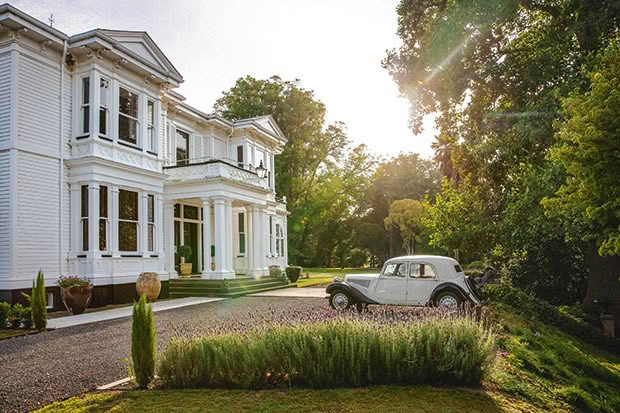
Tim bought his 1951 Light 15 Citroën while training to be an officer in the air force back in 1979. “Like the house, I pulled it apart and put it back together again. For many years, it was my only car”. The downstairs hall (image above) has a mix of original colonial-era fixtures and Asian antiques. Tim filled a 40-foot container in Malaysia to the brim with antique furniture and movie memorabilia, such as the altar table from the television series Marco Polo and the ebony marble bench from the romantic comedy Crazy Rich Asians.
Today Tim and his Vietnamese-Canadian partner Duyen Hackett are in post-production mode in Waipukurau, less than 10 minutes from where he grew up. But this rural operation is a touch slower than their past film and television projects, such as Crazy Rich Asians and Disney’s live-action Mulan.
There are no cameras or movie stars at Mount Vernon Villa, their recently restored Victorian-era homestead. It’s just a crew of two — he a producer and she a wellness coach/caterer for film crews and events. And after returning from an eight-month television stint in Thailand, they are off-duty and home at last. “When you’ve lived in a city all your life and then come home to a place like this, it feels like a blessing,” says Duyen, who’s lived in Hong Kong for most of her adult life.
Getting a break from work means the gallop slows to a trot. Together, Tim and Duyen bottle peaches they’ve plucked from their orchard and snip silverbeet from the veggie patch out back. It’s a scene they and their frequent visitors could practically drink up — 14 hectares of rolling countryside and homemade quincello (a limoncello-esque tipple made with last year’s quince harvest) always go down a treat.
- The verandah and surrounding lawns act as a red carpet for hosting friends (and friends of friends). The couple loves a good party and doesn’t mind if the show goes on without them.
- Paella cooked over the open fire is Duyen’s favourite for feeding — and entertaining — a hungry crowd.
- Last year Tim and Duyen had lavish costumes all sorted for their art-deco themed party then suddenly had to rush off to Thailand to film a new television series. Their friends came and partied anyway.
The 14-hectare park-like surrounds are dotted with pockets of native trees and old beauties, including eight types of pines and spruces, and redwoods, oaks, elms, and other arboretum-worthy specimens.
“Home” is an ambiguous word for a man who’s lived out of a suitcase for much of his career. In the 1980s, the aspiring producer moved to Auckland to start forging his way into the industry.
At his first entry-level gig, Tim was told he needed overseas experience. So he got it, moving to Britain, where he worked on films such as Clockwise (1986) and Stanley Kubrick’s Full Metal Jacket (1987). Four years later, he returned and built his career while living on a vineyard in Kumeū, where he and his then-wife stayed with their two children for 20 years.
If Tim’s life were a highlight reel, it would be an around-the-world montage, heavy on scenes throughout Asia and the South Pacific. New Zealand has always been home, and the filming location of many films attached to his name (such as the first two Chronicles of Narnia films, Emperor and Mr. Pip). But give him a choice, and he’ll most definitely be off. “If I were asked to do a film somewhere far away like Mongolia or in New Zealand, I’d probably always choose the place that’s farther. I love the challenge,” he says.

The lawn beckons guests for a spirited round of croquet, played with this set made by Ōtāne wood mallet-maker George Wood; legend has it that the two majestic elm trees shading the lawn games were planted by (original owner) John Harding’s two daughters in the late 1880s. The story goes that while they were riding up from Wellington, the girls broke pieces off an elm tree to use as riding crops for their horses. “When they got to Mount Vernon, they poked them in the ground to grow. No idea if the story is true, but I suspect it is since elms will grow from a splinter,” says Tim.
Many of the most significant rewards in life begin with a challenge. One day in 2017, while in Malaysia for the production of Crazy Rich Asians, Tim found himself scrolling through property listings for a new home base in New Zealand. And there it was — Mount Vernon for sale.
Despite last seeing the colonial estate as a young boy, he could picture the nuts and bolts of its renovation as if it were a historical blockbuster. No matter that part of the 19th-century homestead hadn’t been lived in for 80 years or that it would likely cost double what he expected.
It was ambitious, but a good producer can see the big picture beyond the nitty-gritty. “I had last seen the property when I was about eight years old,” he says. “And I’m a bit of a sucker for buying things on an emotional basis.”
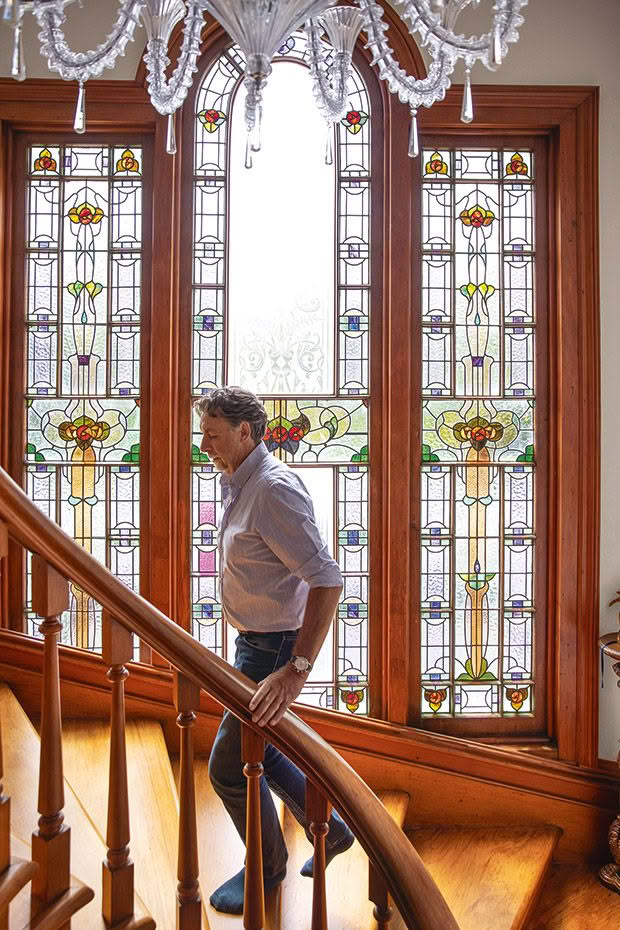
The grand central staircase, made of kauri, leads to another hallmark of the villa — an original stained-glass window with the maker’s signature intact.
Was he a touch mad to buy a fixer-upper based on childhood memories? Most definitely, laughs Duyen, though she’s no stranger to a life wrought with unexpected twists and turns. Born in post-war Vietnam, she was a child when her family moved to Vancouver, Canada.
Itchy feet led her back to Asia soon after finishing high school. The 20-year-old arrived in Hong Kong to travel but stayed for a year to volunteer at a Vietnamese refugee camp. It was tough, and her rusty Vietnamese made communication challenging. Then a friend offered her a job as head chef for a glam eatery.
Wait, a head chef at 20? “I had done work in restaurants before but not as a chef — certainly not a head chef. When I was asked to do stock-take at the end of my first month, it was so embarrassing having to go to the boss to ask what to do,” she says.
- Tim’s books and memorabilia are displayed in the study. It’s unlikely the homestead’s original owner, a leader in the 19th-century temperance movement, would have approved of the Italian drinks trolley Tim won at a Webb’s auction.
- The antique desk where Tim spends most of his workday is from the set of the 2012 war drama The Emperor. The workplace becomes a cosy reading nook by the original fireplace in the evening. “The study has different moods throughout the day,” says Tim. The villa’s antique clock got a new lease on life from a clockmaker from Waipawa.
But Duyen had found her calling. She also found that Hong Kong suited her; it’s where she and her former husband raised two children. (They turned out to be as intrepid as herself, with one now based in Toronto and the other in London.)
What the metropolis lacked, however, was decent Vietnamese cuisine. So in the 2000s, she went from chef to restaurateur. Her first eatery was called Song, an upscale Vietnamese restaurant, and then came Noodle Mi, a trendy noodle bar serving fast-yet-fresh dishes. One local paper dubbed her the “Phở Queen”.
- Jade-green paint, modern appliances and an extensive renovation have made the kitchen unrecognizable from its original 19th-century layout. Imported marble bench tops nearly made it here from China until the largest bench was dropped twice in the shipping process. Tim finally replaced it from a supplier in Hawke’s Bay.
- Duyen is often found in the kitchen, either whipping up something delicious (“there’s no Uber Eats here”) or working at the bench on her laptop. If cooking an Asian dish, she’ll make an excuse to drive 45 minutes to Hastings’ Asian Grocery.
“I’ve always been a person on the go. You can’t really pin me down for more than three months because I’m either doing or looking for something to do,” she says.
By the time she met Tim, she had gone from restaurateur to caterer for high-profile events and film crews (which is how their paths crossed). Her international catering business (duyencatering.net), which focuses on wellness and nutrition, has put on spreads for Sir Elton John, Louis Vuitton, the World Economic Forum and Art Basel. She has also worked on movie sets, including Transformers: Age of Extinction and Godzilla vs Kong.
- Plush textures and pops of colour bring energy to each of the white-walled rooms. “The house is bold yet old. We wanted it to look like it had been beautifully looked after. Bolts of colour give each room a signature and bring them into this century.”
- En-suite fittings, such as showers, taps, basins, and hardware, are from Heritage Bathware in Christchurch. One would never know the master en suite (above) was a bedroom in its pre-renovation life; the villa’s original grand piano in the sitting room (above right) was made in 1824.
This couple knows a thing or two about making things happen — be it films, food, or creating a home fit for entertaining. Mount Vernon, built in 1882, had its last major renovation after the 1931 Napier earthquake. Preserving the building’s character while bringing it into the 21st century required extensive work — 12 months from cellar to dome.
Tim slept in the study while the rest of the house was stripped, sanded, rewired, replumbed and restored by the experts. “In pulling the house apart and putting it back together again, I probably know it better than those who have lived here their whole lives. That’s a wonderful way to know your home,” he says.
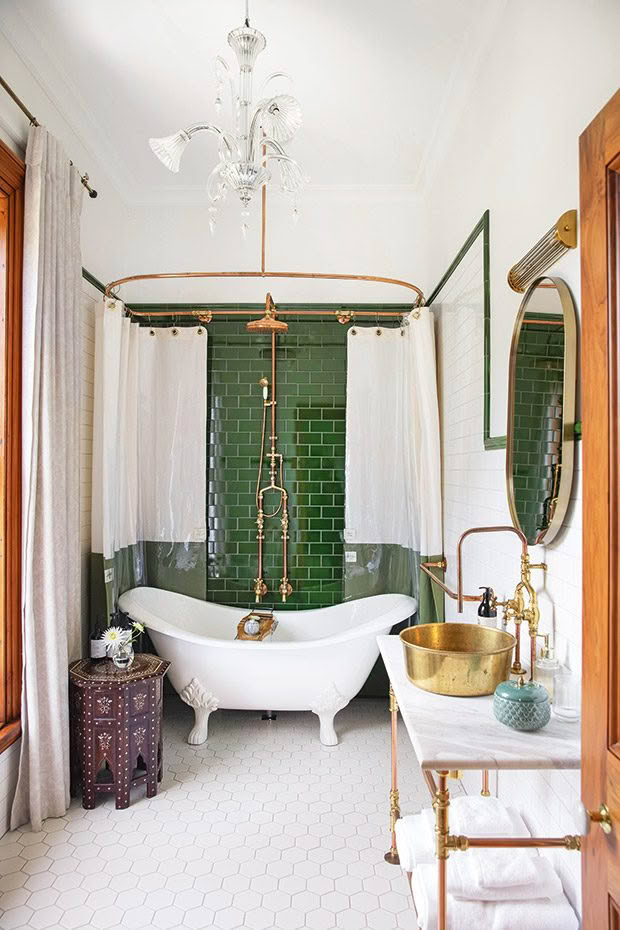
The en suite across the hall from Tim and Duyen’s room is their favourite. Before the renovation, the space and adjoining bedroom had been so severely damaged in the 1931 Napier quake that the walls had collapsed and there was little ceiling left. The cast-iron bathtub was found on Chinese e-commerce giant Alibaba — Tim and Duyen ended up buying five altogether for the villa.
In late 2019, a few months before the entire country shut down thanks to the pandemic, Mount Vernon was finally complete. Tim and Duyen were in LA for a movie premiere when rumours began circulating that country borders could close.
They raced back home and, as it turned out, Aotearoa couldn’t have been a more perfect place to land for two people in the entertainment industry. By the end of 2020, the couple had resumed business as usual for the live-action Netflix series Cowboy Bebop, filmed in Auckland.
- Pieces of stained glass found in the basement and sheds were used to restore the window on the south end of the verandah.
- There’s always picking and preserving to be done with such an ample orchard, which includes 14 pear trees, six plums, an adjacent citrus orchard, figs, peaches, quinces and just about every nut tree there is.
- Tim and Duyen’s green-thumbed neighbour Jo Richards is more than happy to look after the grounds and villa whenever they are away. The only bedroom on ground level (formerly an abandoned dining room) spills out to a manicured rose garden.
Tim may not believe in such a thing as the perfect film, but he does believe magic happens when the right people, props and setting come together. Perhaps something along those lines has happened here in Waipukurau.
Entertainment is in the homestead and the couple’s DNA; on any given week, the laughter of friends and family can usually be heard bouncing from the veranda and across the manicured lawns. “Mount Vernon comes alive with people — it is built for it,” says Tim.
Sometimes Tim and Duyen swap roles, too; after months of cooking for an occupation, she will concede dinner duty from time to time (Tim makes a mean roast pork with crackling).

Tim, who recalls trotting around Waipukurau as a child, has a soft spot for his three polo ponies.
Indeed, this is the one scene of which they will never tire. “It’s funny because I wanted to get as far away from Waipukurau as possible as a teenager,” says Tim. “Now it’s become our rock that we can’t get enough of.”
MOUNT VERNON: A TIME CAPSULE
This grand old lady would have plenty of stories to dish if walls could talk. The two-storey homestead at Mount Vernon Station was built in 1882 by local settler John Harding, a staunch prohibitionist and one of the first colonists to put down roots in Central Hawke’s Bay.
The homestead’s architecture was inspired by (and named after) the historic Virginia home of United States President George Washington.
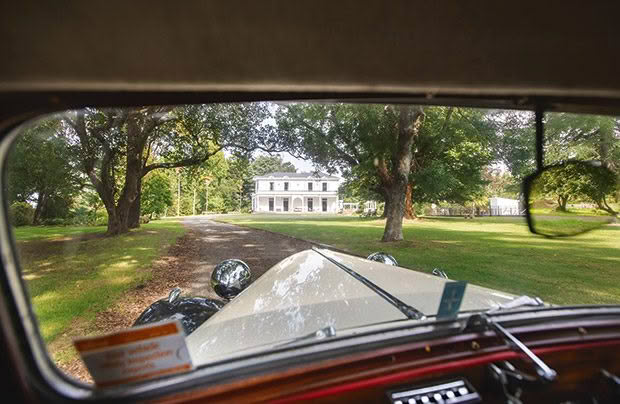
The front lawn offers a preview of what Tim believes is the star of Mount Vernon — the expansive grounds. The ponds below a rebuilt Monet-style bridge will be filled this year, bringing the landscape one step closer to its former glory. “In its heyday, Mount Vernon’s grounds would’ve been park-like. If I can get it even close to that, I will be very happy,” says Tim.
In its 19th-century heyday, Mount Vernon extended across more than 6000 hectares, including a large sheep and cattle farm, an on-site orchard, and a formal garden filled with imported plants. “Gardens were considered a status symbol back then,” says Tim, who has since unearthed Harding’s receipts from nurseries as far away as San Francisco.
Mount Vernon was empty until the 1950s after being severely damaged during the Napier earthquake; it remained in the Harding family until Tim bought it in 2017.
Today, the villa sits on 14 hectares of grounds, including a vast orchard (passed on from the previous owners), a tennis court, an organic veggie garden, a pool, and stables for Tim’s three polo ponies.
HOMEMADE
Mount Vernon Villa’s renovation began with an overhaul of its colonial innards: adding gas, rewiring, re-concreting the basement, adding sprinklers to the extensive grounds and a total rework of the plumbing.
The one-and-only bathroom wouldn’t quite do for a home destined for entertaining; the couple removed some rooms to accommodate en suites for the six remaining bedrooms. “I wanted it to be bright and have an energy to it, so it didn’t feel like you’re walking into a museum or the house of ‘Miss Havisham’,” says Tim.
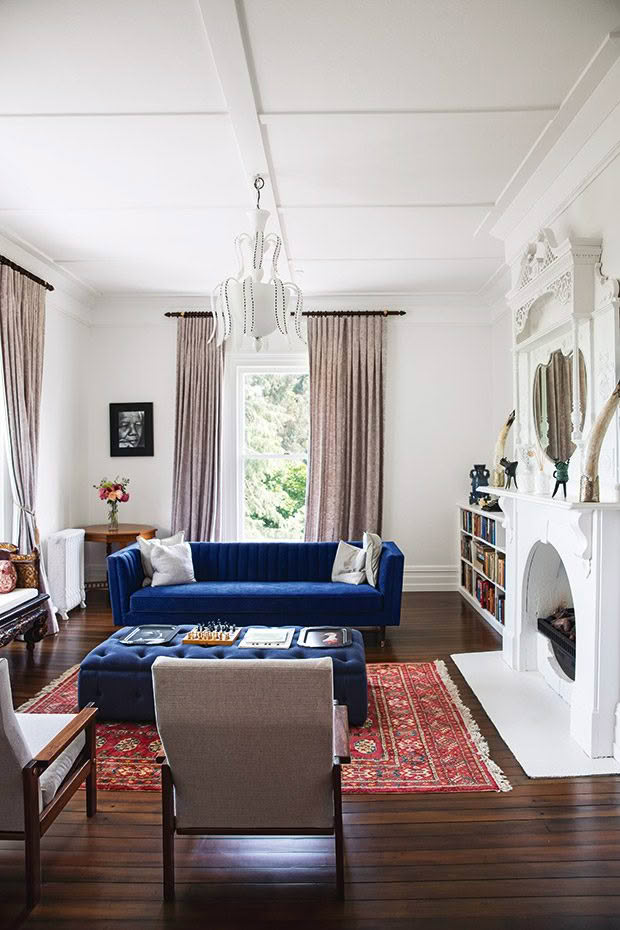
The upstairs lounge, one of three living spaces in the villa, was originally a day room used as a bedroom. Some of the original lath-and-plaster walls were kept in the renovation, while others had rotted beyond saving. Tim bought the signed Nelson Mandela portrait by American photographer Herb Ritts at a charity auction. “Mandela is such a man of our times.”
But he couldn’t go too modern either, not with its heritage-listed pedigree. Tim paired practical touches — central heating and in-wall speakers — with classic furnishings that matched the building’s past.
More than 2000 books are shelved in the library, most more than a century old and once belonging to the homestead’s original owner. Meanwhile, top-of-the-line appliances in the kitchen allow Duyen to whip up a spread 21st-century style. Mount Vernon is available for villa hire and selected private events. mtvernonvilla.com
Love this story? Subscribe now!
 This article first appeared in NZ Life & Leisure Magazine.
This article first appeared in NZ Life & Leisure Magazine.
